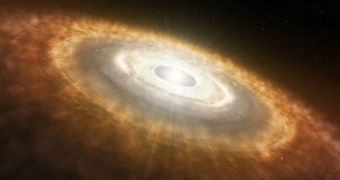Washington University in St. Louis (WUSL) astronomers propose a new model to explain the formation of the solar system. At this point, most of the international scientific community accepts that the planets developed from a protoplanetary disk.
This feature, formed even before the Sun finished maturing, held tiny gas and dust particles. In time, the particles coalesced around growing centers of gravity, and formed increasingly large space rocks.
Fast-forward into the future a little bit and you get planetesimals, small-scale asteroids and planets that continue to collide and come together. This process repeats itself many times, eventually leading to the formation of all the planets, dwarf planets, asteroids and everything else in the solar system.
Russian astronomer Victor Safronov was the first to propose the model, and his calculations were refined by planetary scientist George Wetherill. Since 1970, when it was made available in English, it has remained largely unchanged. It's official name is the Solar Nebular Disk Model.
Though most astronomers agree with this explanation, there are those who believe that alternative ideas need to be explored first. For starters, some believe that fractal assembly, of the type proposed by the SNDM to have guided planetary evolution, cannot explain some of the features we see today.
All planets revolve and spin around the Sun in the same way, and roughly in the same plane (with the notable exception of Pluto). WUSL experts now provide a new model to explain why this happens.
Professors of earth and planetary sciences Anne Hofmeister, PhD, and Robert Criss, PhD, published details of their proposal in the March issue of the scientific journal Planetary and Space Science.
The most important thing to note about their model is that it relies exclusively on classical physics, the laws of thermodynamics and mechanics. Their theory proposes the existence of a 3D gas cloud that formed the Sun and all planets as it contracted (collapsed).
Unlike the SNDM, this model suggests that temperatures in the early solar system were very low, not very hot. It also states that the pre-solar nebula was three-dimensional, whereas the previous model calls for a largely 2D protoplanetary disk.
The main advantage it has over the competition is that it explains planetary orbits and spins as they are now. The new proposal also suggests that the mass of planets determines the size and layout of their satellite systems through a process of gravitational competition, Science Blog reports.

 14 DAY TRIAL //
14 DAY TRIAL //